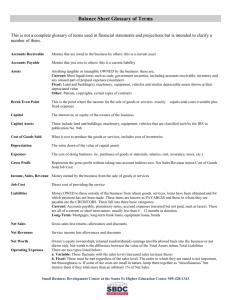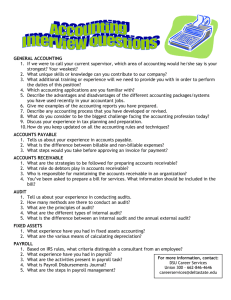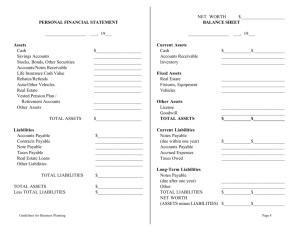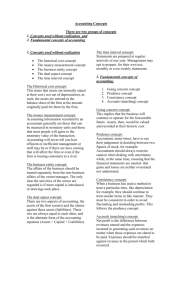Understanding & Interpreting Financial Statements
advertisement
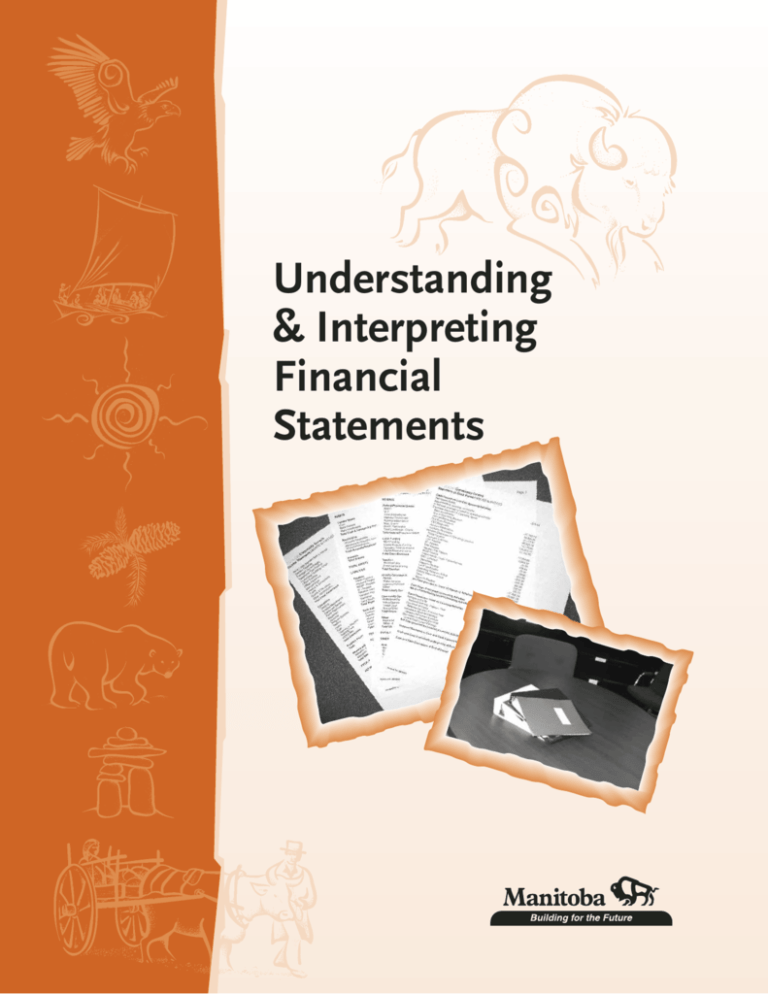
Understanding & Interpreting Financial Statements Understanding & Interpreting Financial Statements Table of Contents Introduction ..............................................................................................................page 2 Part I – Frequently Asked Questions .......................................................................page 3 1. Who uses community financial statements and why? ...............................page 3 2. When must our community audited financial statements be completed?..............................................................................................page 3 3. How do I know if the audited financial statements accurately reflect the financial position of our community? ......................page4 4. How do I know whether our community is well managed, based on the audited financial statements? ...............................................................page 4 5. How do I know if our community is able to pay its bills? ..........................page 5 6. How do I know if our community has a deficit or surplus; and where it is coming from? .............................................................................page 5 7. What if I want more detail?..........................................................................page 5 8. How can I improve my understanding of financial statements? ...............page 6 9. What do I look for when reviewing an income statement? ........................page 6 Part II – Sample Financial Statements.....................................................................page 7 1. Statement of Financial Position (Balance Sheet) ........................................page 8 2. Statement of Activities (Income Statement)................................................page 10 3. Statement of Change in Financial Position (Statement of Cash Flows)......page 12 4. Notes to Financial Statements....................................................................page 13 Part III – Auditor’s Report ........................................................................................page 14 Introduction F inancial statements are the key to understanding the financial position of your community. They help you determine where your community money comes from, how it was spent and if funds are available to support your Community Management Plan (CMP). Like all governments and businesses, your community must prepare annual financial statements and have them audited by an independent professional auditor. The auditing process ensures that standard methods are used in accounting for revenues, expenditures, assets and liabilities. The objective of financial statements is to communicate information to users. They provide users with information about the allocation and use of funds, the source and type of revenues and to what extent revenues were sufficient to meet expenditures. They also provide a snapshot of how much money was spent and for what purposes, and how cash needs were met. Financial statements assist communities and governments in decision making. To meet the needs of the different stakeholders, community financial statements are prepared in accordance with a standard set of rules recommended by the Canadian Institute of Chartered Accountants (CICA). These rules are known as Generally Accepted Accounting Principles (GAAP). Your community’s financial information is recorded on a regular basis using a computer based accounting program which is capable of providing reports on the community’s financial position at any point in time. Typically, financial statements are produced monthly for review by decision makers. Financial statements are prepared using the accrual basis of accounting. This is the most commonly used accounting method which reports income when earned and expenses when incurred. Financial statements provide important information to a variety of stakeholders: • Community residents • Mayor and Council • Governments It is important for stakeholders to have adequate financial information on which to form opinions and base decisions. To be of value the financial information must accurately represent the financial position of the community at any point in time. In addition, governments, including communities, must comply with the recommendations of the Public Sector Accounting Board (PSAB) of the CICA, which details specific accounting policies and disclosure requirements for government entities. Like all governments, your community must make their financial information publicly available. This is part of a long history of government accountability. Further, as governments cannot meet all the needs of their residents with available funds, the open sharing and discussion of financial information is important in setting community priorities. Community residents have a responsibility to inform themselves and support constructive discussions about the use of available funds. Part of this involves reading and understanding financial statements. This booklet provides tips on understanding and interpreting financial statements and is intended to help you become more knowledgeable about the financial affairs of your community. Part I of this booklet answers some of the questions most frequently asked about financial statements. Part II describes what a standard set of financial statements looks like. Part III details an auditor’s report. Page 2 Part I – Frequently Asked Questions 1 Who uses community financial statements and why? WHO? COMMUNITY RESIDENTS MAYOR AND COUNCIL GOVERNMENTS 2 WHY? - Helps you understand what financial resources are available to your community, how they have been used and assists in planning for the future. - Helps you assess the leadership and management of your council. - Summarizes and verifies important information for planning the community’s financial affairs and supports good decision making. - Provides information validated by a professional and independent auditor. - Provides information on your community’s financial position and its management, which is needed to assess possible impacts on funded services. - Provides information on whether funds were used in accordance with the funding requirements. When must our community audited financial statements be completed? Your community’s fiscal year is from April 1 of one calendar year to March 31 of the next. This is the same 12-month reporting period used by the Province of Manitoba. Community audits must be completed according to an annual audit contract and submitted to the department no later than August 31. Page 3 3 b) forms an opinion that the financial statements are not presented fairly in accordance with GAAP (an adverse opinion). For example, the statements are incomplete. c) is unable to form an opinion on the financial statements because of a limitation in the scope of their examination (a denial of opinion). For example, records are not provided for the audit. How do I know if the audited financial statements accurately reflect the financial position of our community? The audit opinion, which is near the front of the audited financial statements, advises readers whether the statements provide an accurate financial picture. Examples are shown in Part III. • • • Community councils are responsible to have their administrative staff prepare interim or monthly financial statements, as well as, annual year-end financial statements. Communities must hire an independent and professional auditor to review the financial systems and records. To be qualified, an auditor must have completed special training and be a member in good standing of a professional accounting association recognized by the province. The auditors job is to determine the completeness and fairness of the financial statements, in all significant respects. Obviously, the auditors cannot review each and every financial transaction. The auditors perform such tests of the financial records, as they deem necessary in order for them to be able to provide a written professional opinion on the financial statements. Auditors may also provide important information to the community council in a separate management letter. This letter provides advice on issues that the council should review in order to ensure good financial management. 4 How do I know whether our community is well managed, based on the audited financial statements? An unqualified opinion by the auditor means that the financial statements are presented fairly, but is not, in itself, an indicator that the community is well managed. This can only be determined by an analysis of the financial statements to determine what financial resources the community has and how well they are being utilized to meet community priorities. The auditor will provide either an unqualified opinion or a reserved opinion. As discussed in the questions that follow, financial statements will indicate or provide: An unqualified opinion means the financial statements are fairly presented in all significant respects. • • A reserved opinion is provided when the auditor: • a) forms a positive opinion on the financial statements as a whole, but qualifies that opinion with respect to a departure from GAAP or a limitation in the scope of their examination (a qualified opinion). For example, information can not be verified, ie. fundraising activity. Part I A surplus or deficit that is being carried from year to year and how it changes; Whether programs are being operated within budgets and/or funding levels; and Two years of information in order to compare changes from one year to the next. This is a good starting point. However, you will have to review and discuss your community’s audited financial statements in order to understand what the complete financial situation is and how well your community’s finances are being managed. Page 4 Frequently Asked Questions 5 7 How do I know if our community is able to pay its bills? Community councils are required to prepare financial statements using a standardized chart of accounts and to set up programs as outlined in the Financial Management Guide. Each community office has a copy of this guide. In addition, annual audits are performed according to an established audit scope which outlines the level of detail required by the department. To find out, look at the Balance Sheet (see Part II) and compare Current Assets to Current Liabilities. Current assets are those assets on hand (ie. bank deposits, accounts receivable, etc.) which represent a source of funds to cover existing liabilities or finance future operations. The Simply Accounting program used by communities can provide a great deal of additional information. The program can produce over 90 different reports and graphs. However, it is recommended that the following financial statements be utilized by council: Current liabilities are debts of the community that must be paid in the near future (ie. one year or less). If the current assets are greater than liabilities, cash is likely to be available to pay bills assuming that outstanding accounts receivables are collected. If current liabilities are greater, there may be problems paying bills on time. • • • • • • • Important note: The Balance Sheet is a statement detailing what assets and debts the community has on a particular date – ie. at the end of the accounting period to which the financial statements refer. It is historical information. In the case of the annual financial statement, for example, other transactions will have occurred between the time of the completion of the audit, and when the audit findings were released – transactions which may significantly alter the financial situation of the community. 6 What if I want more detail? Balance Sheet Comparative Income Statement Project or Program Reports Accounts Payable Reports Accounts Receivable Reports Employee Payroll Reports General Ledger Report for each Bank account These reports can be produced easily and quickly at any time by your community administrator or clerk upon request. However, some information is confidential (detailed personal information) and it should be managed accordingly. Some transactions will not be included in the reports until a bank reconciliation has been done. Bank reconciliations must be done each month. These will normally be completed upon receipt of the bank statement, generally mid-month. Some adjustments are required when the bank account is reconciled. Generally, these would be minor and limited to bank charges, direct deposits or automated payroll withdrawals. In any event, between bank reconciliations, reports can be generated and the outstanding items can be taken into consideration upon review of your financial statements. How do I know if our community has a deficit or surplus; and where it is coming from? You will want to look at the Income Statement (see Part II) and compare total revenues to total expenditures. Where revenues are greater than expenditures there is a surplus. If revenue is less than expenditures, a deficit exists. The accumulated total of more than one year will be either an accumulated surplus or an accumulated deficit. This amount will appear in the Equity section of the Balance Sheet. Page 5 8 How can I improve my understanding of financial statements? If you do not fully understand your financial statements ask questions. The first person to ask about your financial position is your community administrator or clerk. Second, contact your Municipal Development Consultant from the Aboriginal & Northern Affairs regional office. Third, contact your auditor. Finally, you may wish to seek training to assist you with your areas of concern. You should know the status of your finances at any given time. Generally, the following practices will assist you to improve your understanding of financial statements: 1. Know your business: a. Community Management Plan b. Annual Operating Budget c. Maintenance Management Plan d. Capital Expenditure Plan e. Funding Schedule & other revenue sources f. Reporting requirements g. Accounting cycles & timelines 2. Establish a specific set of financial statements for your meetings: a. Comparative Income Statement b. Program/Project Reports c. General ledgers for bank accounts d. Others as required 3. Attend all council meetings: a. Review your information packages prior to your meetings b. Participate and encourage discussion about your financial statements c. Share your ideas and information d. Stay focused/follow your plans 4. Hold public meetings to keep yourself & the community informed: a. Present your audited financial statements b. Develop annual reports which review your community plans and financial information using various reporting methods Part I Page 6 5. Hold an annual interview, usually referred to as an exit interview: a. Discuss the audit report with your Municipal Development Consultant and auditor b. This is an opportunity for administrative staff and council to discuss and respond to issues or concerns raised in the audit report 9 What do I look for when reviewing an income statement? Normally, differences occur between budget figures and actual figures. The community administrative staff should be able to explain any differences between the amount of revenue expected (budgeted) and the actual amount received or between the expense budgeted for and the actual expense incurred. Differences may exist because: • a transaction occurs later than expected. This is referred to as a timing difference and will sort itself out when the transaction is eventually recorded. • an accounting error was made where a transaction has been allocated to the wrong account. This will require an entry to correct the error. • an unexpected event has taken place that was not included in the budget. • the budget underestimates or overestimates an expected amount. Small differences are not unusual – budgets are estimates after all, but it is a good idea to question large variances to understand if circumstances have changed or errors have occurred which should be corrected. Another thing to look for is large changes in a revenue or expense category from one year to the next. Again, administrative staff should be able to explain the variance which could be due to changes in operations or funding or again, could indicate that an accounting error has occurred and should be corrected. Frequently Asked Questions Part II Sample Financial Statements Financial Statements include the following: 1. Statement of Financial Position (Balance Sheet) 2. Statement of Activities (Income Statement) 3. Statement of Change in Financial Position (Statement of Cash Flows) 4. Notes to Financial Statements Page 7 1 Statement of Financial Position (Balance Sheet): The Balance Sheet provides a snapshot of community council’s financial position at any point in time, but particularly at a month-end or year-end. It is called the balance sheet because the Assets must equal (balance) the Liabilities and Owner’s Equity (A=L+OE). ASSETS are items owned by a council. Current Assets are assets that can be converted to cash or consumed in the ordinary course of operations, and include: • Cash: bills, coins and cheques on hand or on deposit in a bank account. • Accounts receivable (A/R): money owed to a council that is reported as revenue on the income statement and a receivable on the balance sheet. All outstanding A/R is money not yet collected and therefore not available for council to use until collected or paid. This may include money from government funding agencies. An allowance for bad debt may be deducted from the A/R balance to arrive at the net receivable. • Short-term investments. • Other current assets include, for example, prepaid expenses. Other Assets are non-current assets that will not ordinarily be converted to cash in the ordinary course of operations and include: • Reserve investments. LIABILITIES are monies owed by a community council and include: Current Liabilities are debts which must be paid in the ordinary course of operations and include: • Accounts Payable: monies owed by the council for the purchase of supplies and services. • The current liabilities also include ALL due amounts in MEBP, CPP, EI and Federal taxes in year end. Deferred Revenues are revenues received today, but required in the future. These represent the net future liability to the community and include funds for: • Program or service delivery. • Specific project. • Replacement reserves such as those funds allocated for future replacement requirements. These revenues are for a specific purpose and must be spent on the intended use. EQUITY is the difference between the assets and liabilities. Equity has two parts, the current earnings or loss and the accumulated earnings or loss from previous periods. Contingent Liabilities are financial obligations which may arise in the future depending on the outcome of an existing situation that will ultimately be resolved when one or more future events occur or fail to occur. GAAP requires that these be disclosed in the financial statements, usually by a note. Part II Page 8 Sample Financial Statements Balance Sheet Green Meadows Community Council As at March 31, 2004 ASSETS Cash & Investments Bank: Operating Reserve Investments Total Cash & Investments Receivables Accounts Receivable Allowance for Doubtful Accounts Accounts Receivable – Net Total Receivables 2004 2003 16,626.82 47,077.15 $63,703.97 16,761.07 27,750.66 $44,511.73 15,284.19 (0.00) TOTAL ASSETS 14,506.19 (0.00) 15,284.19 $15,284.19 14,506.19 $14,506.19 $78,988.16 $59,017.92 LIABILITIES Current Liabilities Accounts Payable MEBP Medical MEBP Pension MEBP LTD MEBP Life MEBP Payable CPP Payable EI Payable Federal Income Tax Payable Receiver General Payable Total Current Liabilities 3,328.21 5.00 94.08 10.86 7.86 3,181.56 2.50 (3.84) (1.38) (0.14) 117.80 281.36 195.41 447.38 (2.86) 0.00 0.00 0.00 924.15 $4,370.16 0.00 $3,178.70 Deferred Revenue (Projects) Water Treatment Plant Total Deferred Revenue (Projects) 1,939.86 $1,939.86 1,939.86 $1,939.86 Deferred Revenue (Reserves) Waste Disposal Fire truck Tractor Water Breaks Pump Roads & Ditching Total Deferred Revenue (Reserves) 7,329.14 11,249.17 6,259.17 3,303.80 4,059.19 14,876.68 $47,077.15 4,730.25 7,949.17 3,924.17 1,981.23 2,259.19 6,906.65 $27,750.66 TOTAL LIABILITIES $53,387.17 $32,869.22 Current Earnings Retained Earnings TOTAL EQUITY (548.22) 26,149.21 $25,600.99 143.68 26,005.02 $26,148.70 LIABLITIES AND EQUITY $78,988.16 $59,017.92 EQUITY Equity Page 9 2 Statement of Activities (Income Statement): The Income Statement presents information that allows readers to compare actual revenues and expenses to budgeted revenues and expenses. This statement shows the surplus or deficit for the current fiscal year. Note: Budgets must be set at the beginning of the reporting year, as part of the annual community management planning process. Communities must submit a balanced budget (expenditures must equal revenues). REVENUES: Aboriginal and Northern Affairs O&M Funding represents all the monies received or receivable by the community during the year from the department. Examples are core funding and N.A.C.C. grant. User Fees and Other Revenues are all locally generated revenues billed by the community to users; examples may be water & sewer fees, licenses and sale of assets. It is very important to keep an organized account of these revenues to ensure that all revenues are reported and that a proper audit trail exists. Although the amounts are shown as income they are not available for use until collected. Community Operations are revenues generated by the community and not funded by the department, for example, a trailer court operation. EXPENSES: Payroll represents total wages paid or payable by the community to both part-time and fulltime employees for the period in question. Payroll also includes expenses for the community’s portion of EI, CPP and council honorariums. Operation Expenses represent all the monies spent by the community for that year, other than payroll expenses. Examples of expenses are phone/fax/internet, travel, road maintenance, legal and audit fees, hydro, testing, building maintenance. NET INCOME: Net income is the difference between the revenues and expenses for a given period. If revenue is greater than expense, there is a surplus. If revenue is less than expense, there is a net loss or deficit. The surplus or deficit amount is shown on the Balance Sheet as current earnings and at year-end is added to or subtracted from the retained earnings. Part II Page 10 Sample Financial Statements Income Statement Green Meadows Community Council For the year ending March 31, 2004 REVENUE Budget Aboriginal & Northern Affairs O&M Funding Core Funding Operating Reserve N.A.C.C. Total Aboriginal & Northern Affairs O&M Funding 2004 2003 178,324.00 4,700.00 800.00 $183,824.00 178,324.00 4,700.00 800.00 $183,824.00 177,062.00 3,700.00 800.00 $181,562.00 4,500.00 1,321.00 $5,821.00 4,500.00 1,514.00 $6,014.00 4,111.00 1,012.00 $5,123.00 13,165.00 26,480.00 2,950.00 230.00 100.00 $42,925.00 13,323.40 26,162.38 3,000.00 230.00 120.00 $42,835.78 12,564.20 25,033.21 3,100.00 200.00 0.00 $40,897.41 $232,570.00 $232,673.78 $227,582.41 Payroll Wages EI Expense CPP Expense Council Honorariums Total Payroll 118,000.00 3,090.00 3,600.00 8,400.00 $113,090.00 118,345.07 3,085.72 3,619.92 8,320.00 $133,370.71 116,111.26 2,884.20 3,369.76 9,274.13 $131,639.35 Operations Postage/Freight Phone/Fax/Internet Accounting/Auditing/Legal Memberships/Registration Fees Grants and Donations Training Travel Road Maintenance Site Maintenance Building Maintenance Equipment Maintenance Pump Replacement Supplies Hydro Chemicals Testing Other Operations Total Operations 850.00 3,900.00 1,400.00 1,250.00 500.00 3,600.00 8,000.00 16,000.00 1,200.00 13,000.00 2,500.00 5,000.00 5,800.00 16,480.00 5,000.00 2,000.00 13,000.00 $100,000.00 757.12 3,901.00 1,500.00 1,100.00 450.00 3,664.96 7,418.01 16,800.83 1,240.00 13,989.00 2,119.33 4,700.00 5,280.19 17,036.88 4,819.45 1,891.44 13,183.08 $99,851.29 747.02 3,500.00 1,000.00 970.00 350.00 3,496.03 7,321.62 15,411.92 1,365.00 13,452.68 2,250.79 4,807.00 5,396.49 16,325.45 3,224.22 1,895.37 14,285.79 $95,799.38 TOTAL EXPENSE $232,570.00 $233,222.00 $227,438.73 Other Federal/Provincial Grants PTSG VLT Total Other Federal/Provincial Grants User Fees & Other Revenue Municipal Taxes Water & Sewer Services Rentals Licenses/Permits/Fees Sale of Assets Total User Fees & Other Revenue TOTAL REVENUE EXPENSE NET INCOME $(0.00) Page 11 $(548.22) $143.68 3 Statement of Change in Financial Position (Statement of Cash Flows): The Statement of Cash Flows describes where your money came from and where it went over a certain period in the past. This report helps you to examine your ability to generate cash and how you use it. It also breaks down your cash flow into three categories for easier analysis: • • • Operating Activities would include the excess of revenues over expenses, adjusted for items not requiring a current outlay of cash and the changes in the working capital balances related to operations. Financing Activities would include the receipt of debt proceeds and any increase or decrease in replacement reserves. Investing Activities would include the purchase and sale of capital assets. In essence, this report shows the changes to various accounts over a reporting period. Similar information can be obtained by comparing two balance sheets, one from the day before the beginning of the period and one for the end. This statement can be created only within a fiscal year (either this year or last). The Cash at End of Year details should match the related Assets on the Balance Sheet. Statement of Cash Flows Green Meadows Community Council For the year ending March 31, 2004 Cash Flows from (used in) Operating Activities Net Income (Loss) Adjustments to reconcile net income to net cash provided by (used in) operating activities: Decrease (Increase) in Operating Assets Accounts Receivable Increase (Decrease) in Operating Liabilities MEBP Medical MEBP LTD MEBP Life Accounts Payable CPP Payable EI Payable Federal Income Tax Payable Net Cash provided by (used in) Operating Activities Cash Flows from (used in) Financing Activities Increase in Debt MEBP Pension (Decrease) in Debt MEBP Pension Net Cash provided by (used in) Financing Activities Increase (Decrease) in Cash and Cash Equivalents Part II 2004 (548.22) 2003 143.68 (777.49) (659.43) 2.50 12.24 8.00 146.65 281.36 195.41 447.38 $(232.17) 22.50 24.13 8.00 243.64 274.21 148.35 432.17 $637.05 645.12 632.21 (547.20) $97.92 (947.31) $(315.10) $(134.25) $321.95 Cash and Cash Equivalents at Beginning of Period $16,761.07 $16,439.12 Cash and Cash Equivalents at End of Period $16,626.82 $16,761.07 Page 12 Sample Financial Statements 4 Notes to Financial Statements The notes to financial statements are very important in understanding the financial statements and provide more information beyond what is shown in the financial numbers of the statements. The notes explain significant accounting practices and provide additional information on other matters that will affect the financial position of your community. The type and amount of information included in the notes will vary from community to community. At a minimum, the notes should include useful details on: • The accounting policies used by the community • Accounts Receivable Below are some examples of explanatory notes to financial statements. Green Meadows Community Council Notes to Financial Statements Year Ended March 31, 2004 1. Significant Accounting Policies Revenue and expenditures are recorded on an accrual basis. 2. Accounts Receivable Interest Reimbursement Water services GST Rebate Less: Allowance for Doubtful Acc Net Accounts Receivable 2004 150 1,560 3,000 3,200 2003 0 100 1,500 1,050 $7,910 $2,650 (500) (200) $7,410 $2,450 Page 13 Part III Auditor’s Report The covering report by the independent auditor that accompanies the audited financial statements includes important information. The report details the scope of the audit - what the auditor examined, for what period and in accordance with what standards. It also includes the auditor’s opinion on the accuracy of the financial statements. The auditor will provide an unqualified, qualified or adverse opinion, or a denial of opinion. An example of an Unqualified Opinion is shown below. ABC Professional Accountants AUDITOR’S REPORT To the Members of Green Meadows Community Council We have audited the balance sheet of Green Meadows Community Council as at March 31, 2004 and the statement of operations and surplus for the year ended. These financial statements are the responsibility of the community council’s management. Our responsibility is to express an opinion on these financial statements based on our audit. We conducted our audit in accordance with Canadian generally accepted auditing standards. Those standards require that we plan and perform an audit to obtain reasonable assurance whether the financial statements are free of material misstatement. An audit includes examining on a test basis, evidence supporting the amounts and disclosures in the financial statements. An audit also includes assessing the accounting principles used and significant estimates made by management, as well as evaluating the overall financial statement presentation. In our opinion, *these financial statements present fairly*, in all material aspects, the financial position of the community council as at March 31, 2004 and the results of its operations and its cash flows for the year then ended, in accordance with Canadian generally accepted accounting principles. Signed by ________________________________________ ABC Professional Accountants Winnipeg, Manitoba Date ____________________________________ Page 14 When an auditor has reservations, they will detail them in a separate paragraph before the opinion paragraph. A Qualified Opinion would be indicated with wording similar to “…*except for the effects of the adjustment referred to in the preceding paragraph, these financial statements present fairly*…” An Adverse Opinion would be indicated with “…*these financial statements do not represent fairly*…” A Denial Opinion would be indicated with “…*we are unable to express an opinion whether these financial statements are presented fairly*…” The department requires that the community maintain at least a qualified audit or better, preferably an unqualified audit. Page 15 NOTES





